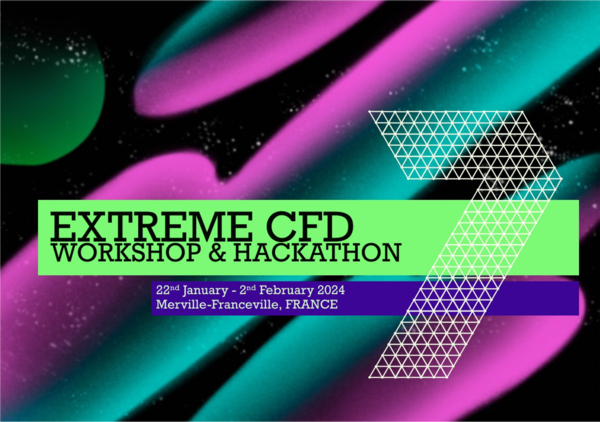ECFD workshop, 7th edition, 2024
Contents
- 1 Description
- 2 Agenda
- 3 Thematics / Mini-workshops
- 4 Projects
- 4.1 Hackathon - P. Begou, LEGI
- 4.2 Mesh adaptation - R. Letournel, Safran
- 4.3 Numerics - S. Mendez, IMAG & G. Balarac, LEGI
- 4.3.1 WIP N1: High-Order schemes for Navier-Stokes - M. Bernard & G. Balarac (LEGI) & G. Lartigue (Total Eneriges)
- 4.3.2 N5: Optimization of the RBC solver - F. Rojas & S. Mendez (IMAG)
- 4.3.3 N6: Electrodeformation of red blood cells, extension to 3D and improved accuracy at membrane - A. Spadotto & S. Mendez (IMAG), M. Bernard (LEGI)
- 4.4 Turbulence - P. Benard, CORIA & L. Bricteux, UMONS
- 4.5 T4: Atmospheric solver
- 4.6 Two Phase Flow - M. Cailler, Safran Tech & V. Moureau, CORIA
- 4.7 Combustion - K. Bioche, CORIA & R. Mercier, Safran
- 4.8 User Experience & Data - L. Korzeczek, GDTech
Description
- Event from 22th of January to 2nd of February 2024
- Location: Hôtel Club de la Plage, Merville-Franceville, near Caen (14)
- Two types of sessions:
- common technical presentations: roadmaps, specific points
- mini-workshops. Potential workshops are listed below
- Free of charge
- More than 70 participants from academics, HPC center/experts and industry.
- Objectives
- Bring together experts in high-performance computing, applied mathematics and multi-physics CFDs
- Identify the technological barriers of exaflopic CFD via numerical experiments
- Identify industrial needs and challenges in high-performance computing
- Propose action plans to add to the development roadmaps of the CFD codes
Agenda
Thematics / Mini-workshops
These mini-workshops may change and cover more or less topics. This page will be adapted according to your feedback.
To come...
Projects
Hackathon - P. Begou, LEGI
Mesh adaptation - R. Letournel, Safran
Numerics - S. Mendez, IMAG & G. Balarac, LEGI
Finite Volumes method. Distinction between integrate and pointwise quantities. Spacial accuracy depend on ability to evaluate accurately fluxes, starting from integrated quantities. Accurate evaluation of fluxes through interface of each control volume (CV). OK inside the domain, but chalenging in case of boundary conditions : by definition non uniformity of the stencil. BC on faces instead of nodes. Enforcement of the BC by modifying the normal component of the wall gradient in order to evaluate accurate diffusif flux. Treatment of inlet BC by integrating convective flux through each boundary-facelet.
N5: Optimization of the RBC solver - F. Rojas & S. Mendez (IMAG)
N6: Electrodeformation of red blood cells, extension to 3D and improved accuracy at membrane - A. Spadotto & S. Mendez (IMAG), M. Bernard (LEGI)
The Leaky Dielectric Model is a popular framework to describe electric stresses over micro-scale membranes. In particular, we adopt it to simulate the effect of a DC field on a red blood cell. The goal of the project is to reproduce the electric charging process of the membrane as well as the emerging stresses. From the point of view of implementation, the grid is represented by a 2D mesh embedded in a 3D eulerian grid. The need to make variables stocked on the surface interact with quantities stocked on the grid calls for a proper bidirectional 2Dmembrane/3Dgrid connectivity. Advancement on this has led to the simulation of a charging, not moving spherical shell. Moreover, the estimation of grid variables on elements cut by the membrane has been improved thanks to a High Order extrapolation. The latter has tested successful on 2D configurations. The project opens the way for a series of validation tests. In particular, future work will demand treatment of instabilities emerging in symmetrical configurations.
Turbulence - P. Benard, CORIA & L. Bricteux, UMONS
T4: Atmospheric solver
Wind turbines, bigger and bigger, are now influenced by atmospheric flows. An atmospheric solver has already been developed in YALES2 to represents some of its effects (Coriolis, veer, thermal stratification). In this continuum, the project has been divided into two work-packages. - Work-package 1: The use of the Variable density solver (VDS). Before ECFD7, thermal stratification was taken into account using the Boussinesq buoyancy approximation within the incompressible solver framework. Now, VDS can be used, taking into account all thermal effect. Results are promissing. - Work-package 2: Wall law velocity filtering. Wall law are using velocity at the first grid node to compute wall shear stress. Before ECFD7, atmospheric wall law were using the local velocity, leading sometimes to convergence errors. Now a gather-scatter filter can be used to average velocity (and température) at first grid node.


